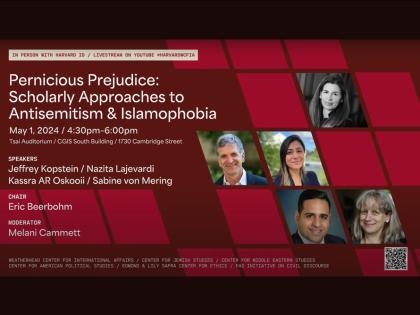We like to believe we're fair-minded, democratic, unbigoted. Would it were so. In fact, we readily deceive ourselves about our prejudices, stereotypes, racial profiles, and ingrained biases. Mahzarin Banaji, Cabot professor of social ethics in the department of psychology and Pforzheimer professor at the Radcliffe Institute, can prove it. In collaboration with Anthony Greenwald, Ph.D. '63, of the University of Washington, she has developed a psychological test that has collected data from 1.5 million website visitors since 1998. It demonstrates that nearly all of us have unconscious, preformed attitudes about race, sex, ethnicity, sexual preference, and obesity. "Yet when we ask people about their attitudes, that's not what we hear," Banaji says. "People report holding neutral attitudes. What people say explicitly is quite different from what the tool shows about their implicit attitudes. It's the dissociation or split between them that's interesting."
 |
| Banaji |
| Photograph by Stu Rosner |
Banaji, who works in the area of "social cognition," doesn't believe people are dissembling about their attitudes. "They truly believe that their attitude is neutralmost of us believe in fairness and egalitarianism," she says. But unconscious stereotypes are deeply embedded in both individuals and cultures. Common associations, like male:science or female:liberal arts, are stubbornly fixed in the unconscious, even when they run counter to consciously held beliefs. Banaji and Greenwald's Implicit Association Test (IAT) ferrets out these buried, automatic attitudes.
The IAT is available on-line. Its several versions plumb attitudes toward race, ethnicity (Asian American, Arab/Muslim), gender, sexual orientation, age, and body image (fat/thin). The racial IATs have drawn 500,000 responses, more than any other version. For five to 10 minutes (working at top speed to forestall conscious consideration), subjects sort pictures and words ("wonderful," "agony," "happy," "failure") into categories by using two computer keys. The IAT measures "latencies" (time delays) in response: which association takes longer to make, blackbad or blackgood? By computing the average difference in latencies between dozens of such pairings, the researchers quantify the IAT effect. "Speed reveals what is hidden from conscious awareness," Banaji says. "The architecture of the mind is such that when two things are repeatedly paired in our experience, we will respond quickly to their co-occurrence." a highly educated professional like Banaji admits, "I was taken aback by my inability to make the intended association, the difficulty in making the counter-stereotypical association between, say, female and career, or male and home." An analysis of 600,000 completed website tests shows that this incapacity is common. Intellectual knowledge is powerless to change certain drummed-in perceptions.
 |
| One Implicit Association Test measures how quickly we associate harmless objects, like flashlights, and weapons, like medieval axes, with African-American or European-American identity. |
| Mahzarin Banaji |
"The data suggest that our conscious and unconscious thoughts and feelings may be quite dissociated," Banaji reports. The gap between the conscious and unconscious has long interested psychoanalysts as well, but Banaji, an experimental psychologist, draws on a very different toolbox. "These are replicable methods, not case-based ones like those of psychoanalysis," she says. "[The IAT] can reveal the disparity between conscious and unconscious in just about anybody, and do it in a way that makes it accessible to the person taking the test."
Race, for example, shows large divergences between expressed and implicit attitudes. Overall, 73 percent of all test-takers automatically favored white over black. Explicitly, both black and white subjects preferred their own group, with blacks giving an especially strong endorsement to blackness. But the IAT reveals that unconsciously, whites prefer white to a much greater degree than admitted, and black subjects are close to neutral. Another kind of racial IAT explores weapons and race linkages, using photographs of old weapons like cannons and medieval axes that are not particularly associated with African Americans. Nonetheless, 70 percent of white subjects associated weapons with blacks, while only 7 percent linked them with whites.er, even implicit attitudes can be influenced. Several of Banaji's students have done lab experiments to show that situational factors, like receiving the IAT from a black experimenter, or viewing photographs of admired African Americans like Martin Luther King Jr. and Denzel Washington before testing, or reflecting beforehand on a question such as, "What are strong women like?" can mute the strength of unconscious leanings. Furthermore, the experience of taking the IAT, though possibly disturbing, may also have value for the test-taker. "Just as in other areas of life, we want our actions to be in line with our intentions," Banaji explains. "If we are aware of our biases, we can correct for themas when driving a car that drifts to the right, we steer left to go where we intend."







